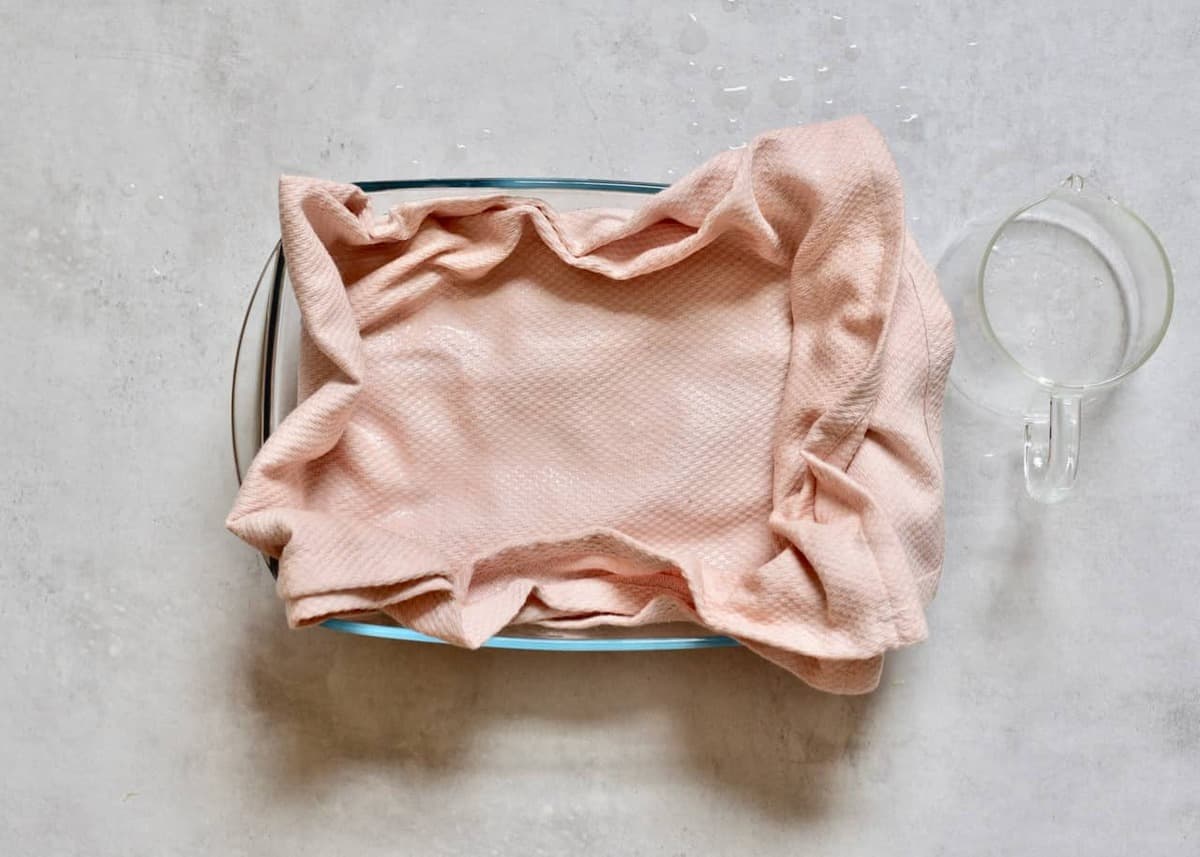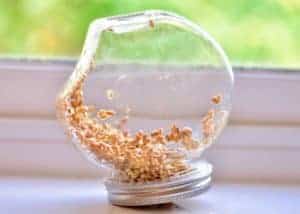Does Wheatgrass Flats Continue to Grow After Cut


This blog post covers not only how to grow Wheatgrass at home with and without soil (which is ridiculously simple to do!), but also the benefits of Wheatgrass and some suggested uses for this superfood!
My introduction to Wheatgrass was seeing it on a TV show growing up as the go-to for a morning 'shot of health'. Let's be honest, the health benefits of Wheatgrass are pretty magnificent. But in terms of money, a daily shot of Wheatgrass bought from your local juice shop is sure to add up. Now, this post will show you how to grow Wheatgrass at home to save your pennies and give you the maximum health benefits.

What is Wheatgrass?
Starting off with something super simple. What is Wheatgrass? It is the first grass of wheat grains, harvested before it reaches full size (usually 7-10 days after sprouting).
The Benefits of Wheatgrass
- Wheatgrass is nutrient-dense & packed with Vitamins: High in iron, calcium and magnesium. It is also vitamin-rich, particularly Vitamins A, C and E as well as containing 8 essential amino acids (meaning our bodies can't produce them alone, so they have to be ingested.)
- It also contains various antioxidants: Which prevent cell damage and reduce oxidative stress as well as possibly protecting against heart disease and cancer and various other health issues.
- Plus, it is one of the best sources for living chlorophyll: Wheatgrass juice, in particular, is one of the best sources available (as long as it is from a fresh, living plant) and the juice contains around 70% chlorophyll. Chlorophyll is in all green plants and has a plethora of health benefits. From reducing inflammation, building blood, energising, deodorising, detoxifying, cancer prevention and weight loss etc. In fact, the majority of benefits from Wheatgrass come from the chlorophyll.
- May aid blood sugar regulation: Although the majority of studies have, regrettably, been on animals and not humans.
- May reduce cholesterol: As well as increasing 'good' HDL cholesterol.
- Could aid weight loss: Due to the thylakoids within the Wheatgrass that seem to increase 'full-ness' and the feeling of satiety, by increasing the release of hormones that decrease hunger.
Not to mention that Wheatgrass has been used to slow down ageing, to neutralise toxins, for it's antibacterial & antiseptic properties, to improve respiratory function (including sinus issues!), get rid of acne and scarring, soothe a sore throat, help keep your bowels 'regular' and is used alongside patients taking chemo to combat the negative side-effects of chemo and more!

How to use Wheatgrass
While Wheatgrass can be bought as a powder or supplement, I will be focusing on uses from homegrown Wheatgrass. Specifically, the most obvious being for your own wheatgrass shots (blog post coming soon!) However, Wheatgrass can also be used to supercharge other juices, smoothies, various other beverages, as well as salad dressings etc.
Super Tip: It's worth noting that if you're only implementing Wheatgrass into your diet now; Wheatgrass can slightly upset your tummy if your body isn't used to its powerful detoxification. To combat this, you can begin by incorporating a 1/2 shot (30ml) into your diet to start with and adjusting the amount over time. (Otherwise, you may experience side effects such as a headache, nausea and fatigue).
Surprisingly, fresh wheatgrass juice isn't just used for ingesting. You can also include wheatgrass juice in your bath to soothe your skin, reduce scarring and acne as well as cleanse the skin. I have even heard of people using it to massage into the scalp (then rinse) to reduce dandruff. As well as applied topically to soothe bites and scratches and soften hands and skin.
I haven't had the chance to use it for any non-food related reasons as of yet. If you have, please let me know what for and if it worked, in the comments below!

How to Grow Wheatgrass at home
Hopefully, I've officially convinced you to add this powerhouse to your diet. With that in mind, let's get into the details of how to grow Wheatgrass at home, with and without soil.
It's also worth noting. Once you've cut the Wheatgrass, you can allow it to grow a second time for more wheatgrass juice. However, after that, I would suggest growing a new batch as the health benefits will get weaker as it's regrown.
What's needed

- Organic wheatgrass seeds
- water
- Sprouting container/glass jar
- Tray
- Soil (if using the Method with soil)
First – sprout the seeds
These first steps are used for both the soil & soilless version.
Rinse the seeds then put in a sprouting container and cover with a mesh. Add 1 cup of water and soak for 8 hours.

Drain and rinse well.
Fill the container with water, invert it and let the water drain through the mesh. Leave it upside down.

Rinse the seeds 2-3 times a day for 2-3 days. Tiny sprouts form within 2-3 days.

How To grow Wheatgrass with soil
When the sprouts appear, it's time to plant. Add 1 inch (2.5 cm) organic compost/ planting soil to a tray (with holes at the bottom) and water it. Sprinkle the seeds across the soil.

Cover the tray with a lid or a newspaper. The darkness will help it grow. Spray it with water daily.

Remove the lid/newspaper when the grass reaches about 1-2 inches (2.5-5 cm) and continue to water daily.

You can harvest when the grass reaches about 5 inches (12 cm). Simply cut the grass close to the root.


How to Grow Wheatgrass Without Soil
Growing wheatgrass without soil is the cheaper, prettier option. However, without the nutrients given to the plant by a good quality organic compost, the plant itself will also grow to have fewer nutrients. It is also more hands-on, in terms of the growth process.
That's not to say that it's pointless to use this method for juicing. However, it's just something worth noting if you're wanting to benefit from the maximum amount of nutrients that you can.

Growing Wheatgrass without soil is fairly similar to the first method. First you need to use the exact same method for sprouting the wheat.
This point is now where the method differs. For soilless wheatgrass, you then spread out your seeds across the bottom of the container and cover with water.

I then covered the container with a cloth for the first night to create a warmer, darker area for them to grow.

You then simply repeat the process of rinsing and draining the seeds a couple of times a day (this is an important step to help you avoid mould!!).

Within a few days the shoots will have started to grow. By day 8/9, they are ready to harvest.
Tip* Keep the container well ventilated to avoid the growth of mould and remember to rinse and drain the seeds a couple of times a day too.

Tip: I have heard of another way, by layering wet kitchen towel on the bottom of your dish , then your seeds and a piece of clingfilm on top. This creates a 'greenhouse' like effect for the first few days, while they begin to grow. I haven't tested this method though and not sure if it would increase the risk of mould. If anyone has had success with this method, please let me know in the comments below.
What next?
You can then use the freshly harvested wheatgrass to juice immediately and consume. The fresh juice can also be kept in the fridge for up to a week (although, it will lose nutritional value over time!). Alternatively, you can freeze portions of 3tBsp juice in a large ice-cube tray.
I go into details as well as explain how to make your own wheatgrass juice in this blog post – How to make Wheatgrass Shots and Juice.

Note: Wheatgrass is susceptible to mould when you're growing it at home, so take notice of any changes. If there are any signs of spoilage or the juice is suddenly more bitter, then have caution and don't drink it! (the wheatgrass roots are 'feathery', so don't mistake this for mould).
Plus, if you're looking for any other DIY inspiration then I have lots to choose from. From How to make Coconut Butter, to Homemade Oat Milk (that isn't slimy) or even DIY Homemade Vegan Nutella. In fact, I have quite a few homemade milks, cheeses, baking ingredients and more.
If you give this DIY a go then please let me know in the comments below! Also, I love to see your creations so feel free to tag me @AlphaFoodie.

- 1-3 tablespoon organic wheatgrass seeds
- water
- soil
-
sprouting jar or regular glass jar
-
Tray
Sprouting the seeds
-
Rinse the seeds then put in a sprouting container and cover with a mesh. Add 1 cup of water and soak for 8 hours.

-
Drain and rinse well. Then fill the container with water, invert it and let the water drain through the mesh. Leave it upside down.

-
Rinse the seeds 2-3 times a day for 2-3 days. Tiny sprouts form within 2-3 days.
Next - choose one of the methods below.

Method 1 - Using soil
-
Add 1 inch (2.5 cm) organic compost/planting soil to a tray (with holes at the bottom) and water it. Sprinkle the sprouted seeds across the soil.

-
Cover the tray with a lid or a newspaper. The darkness will help it grow. Spray it with water daily.

-
Remove the lid/newspaper when the grass reaches about 1-2 inches (2.5-5 cm) and continue to water daily.

-
You can harvest when the grass reaches about 5 inches (12 cm). Simply cut the grass close to the root.

Method 2 - No soil*
-
Spread out the spouted seeds across the bottom of the container and cover with water.

-
Cover the container with a cloth for the first night to create a warmer, darker area for them to grow.

-
Repeat the process of rinsing and draining the seeds a couple of times a day (this is an important step to help you avoid mould!!). Within a few days the shoots will have started to grow.

-
By day 8/9, they are ready to harvest.

* Growing wheatgrass without soil is the cheaper, prettier option. However, without the nutrients given to the plant by a good quality organic compost, the plant itself will also grow to have fewer nutrients. It is also more hands-on, in terms of the growth process.
Note: The Total time does not include the time it takes to germinate the seeds (7-10 days).
Source: https://www.alphafoodie.com/how-to-grow-wheatgrass-at-home-with-without-soil/
0 Response to "Does Wheatgrass Flats Continue to Grow After Cut"
Post a Comment